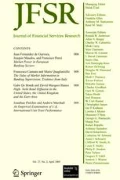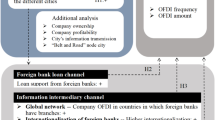Abstract
This article analyses the determinants of European venture capital activity. The main novelty of our work is in accounting for the idiosyncrasies of the European venture capital market. In particular, we investigate whether the size of the merger and acquisition market (M&A) is important in explaining venture capital. Moreover, our work is the first that analyses the impact of the degree of information asymmetry at the macro level, the direct impact of the level of entrepreneurial activity and the impact of the unemployment rate on venture capital activity. We use aggregate data from 23 European countries for the period 1998–2003 to estimate panel data models with fixed and random effects. Our results reveal that the size of the M&A market and the market-to-book ratio have a positive impact on venture capital activity whereas the unemployment rate influences the venture capital market negatively. These results highlight the importance of the exit environment and of the degree of asymmetric information for the venture capital market.
Similar content being viewed by others
Notes
Some related papers do not follow a reduced-form approach. For instance, Marti and Balboa (2001) emphasize venture capital funding including venture capital investments as an explanatory variable. Groh et al. (2010) use composite indices to compare the attractiveness of 27 European countries for institutional investments into the Venture Capital and Private Equity asset class. Schertler (2005) shows evidence that fund providers’ investment preferences matter for venture capital investment characteristics, using a European panel data set.
Schwienbacher (2005) presents evidence regarding the differences between the European and U.S. capital markets. Early stage investments account for 50 % of the total investment for U.S. venture capitalists whereas they represent only 38 % of the total investment for European venture capitalists. Venture capitalists from the U.S. use 59 % convertibles in their investments while Europeans only use 20 %.
Table 5 shows the variables included in the studies that used a reduced form approach. The variables are divided into three groups: macroeconomic variables, entrepreneurial environment variables and technological opportunities variables.
In the case of the U.S., the literature emphasizes the positive influence of the Employee Retirement Income Security Act (ERISA), also known as the «prudent man» rule of 1979, on venture capital activity. By declaring that portfolio diversification should be considered in determining the prudence of an investment, the rule opened the doors to pension funds investing in venture capital.
Some governments give incentives to the creation of self-employment. This may be an additional argument for the unemployed having higher incentives to become entrepreneurs.
According to NVCA and EVCA figures.
Hyytinen and Toivanen (2003) argue that venture capital finance is one of the fields of finance most conducive to asymmetric information, as venture capitalists invest most often in small, technology-based ventures in emerging industries.
The GLS estimator is used because the error terms \( {v_{it}} = {a_i} + {u_{it}} \) are correlated.
Another estimator (used by Jeng and Wells 2000) is the between estimator, which is the OLS estimator of:
$$ {\overline y_i} = {\beta_0} + {\beta_1}{\overline x_{i1}} + {\beta_2}{\overline x_{i2}} + \cdots + {\beta_k}{\overline x_{ik}} + {a_i} + {\overline u_i} $$However, use of the between estimator is questionable. It is biased when the explanatory variables are correlated with a i . In addition, if the explanatory variables are uncorrelated with a i , it is much less efficient than the random effect estimator, as it ignores information on how variables change over time.
Since the dependent variable and most of the explanatory variables are expressed in percentage terms, most of the estimated coefficients indicate the change, measured in percentage points, in venture capital activity when the explanatory variable increases by one percentage point. For instance, when the unemployment rate increases by 1 percentage point, the TotalInvVC (expressed as a percentage of GDP) decreases by 0.012 percentage points. For TEA and MB, the estimated coefficients indicate the change, measured in percentage points, in venture capital activity when the variable increases by one unit.
It should be noted that this last explanation does not apply in the fixed effect regressions. In these models, the unemployment rate coefficient captures within-country variations in the unemployment rate, not variations across countries. Since labour market rigidity in a given country is expected to be relatively stable over time, its effect is eliminated when we use the fixed effect estimator.
References
Acs ZJ, Audretsch DB (1994) New-firms startups, technology and macroeconomic fluctuations. Small Bus Econ 6(6):439–449
Armour J, Cumming D (2006) The legislative road to Silicon Valley. Oxf. Economic Papers
Barry CB, Muscarella CJ, Peavy JW, Vetsuypens MR (1990) The role of venture capital in the creation of public companies: evidence from the going public process. J Financ Econ 27(2):447–471
Black BS, Gilson RJ (1998) Venture capital and the structure of capital markets: banks versus stock markets. J Financ Econ 47(3):243–277
Brav A, Gompers PA (1997) Myth or reality? The long-run underperformance of initial public offerings: evidence from venture and nonventure capital-backed companies. J Financ 52(5):1791–1821
Cumming DJ (2010) A reply to Douglas Cumming’s review essay: public policy and the creation of active venture capital markets. Ventur Cap: Int J Entrep Financ 13(1):95–98
Cumming DJ (2011) Public policy and the creation of active venture capital markets. Ventur Cap: Int J Entrep Financ 13(1):71–94
Cumming DJ, MacIntosh JG (2003) A cross-country comparison of full and partial venture capital exits strategies. J Bank Financ 27(3):511–548
Da Rin M, Nicodamo G, Sembenelli A (2006) Public policy and the creation of active venture capital markets. J Pub Econ 90:1699–1723
EVCA (2002) Survey of the economic and social impact of venture capital in Europe. Res. Pap. from EVCA
Francis BB, Hasan I (2001) The underpricing of venture and nonventure capital IPOs: an empirical investigation. J Financ Serv Res 19(2–3):99–113
Gompers PA (1995) Optimal investment, monitoring, and the staging of venture capital. J Financ 50(5):1461–1489
Gompers PA (1996) Grandstanding in the venture capital industry. J Financ Econ 42(1):133–156
Gompers PA (1998) Venture capital growing pains: should the market diet? J Bank Financ 22(6–8):1089–1104
Gompers PA, Lerner J (1998a) Venture capital distributions: short-run and long-run reactions. J Financ 53(6):2161–2183
Gompers PA, Lerner J (1998b) What drives venture capital fundraising? NBER Working Pap. Nº 6906, Harvard University, Cambridge, MA
Gompers PA, Lerner J (1999a) The venture capital cycle. MIT Press, Cambridge
Gompers PA, Lerner J (1999b) Conflict of interest in the issuance of public securities: evidence from venture capital. J Law Econ 42(1):1–28
Gompers PA, Lerner J (2001) The money of invention: how venture capital creates new wealth. Harvard Business School Press, Boston
Groh AP, Von Liechtenstein H, Lieser K (2010) The European venture capital and private equity country attractiveness indices. J Corp Financ 16:205–224
Hellmann T (1998) Discussion of: what drives venture capital fundraising? In: Baily M, Reiss e P, Wiston C (eds). Brooking papers on economic activity: microeconomics, pp 197–203
Hyytinen A, Toivanen O (2003) Asymmetric information and the market structure of the V.C. industry. J Financ Serv Res 23(3):241–249
Jeng LA, Wells PC (2000) The determinants of venture capital funding: evidence across countries. J Corp Financ 6(3):241–289
Marti J, Balboa M (2001) The determinants of private equity fundraising in western Europe, Working pap
Megginson WL, Weiss KA (1991) Venture capitalist certification in initial public offerings. J Financ 46(3):879–903
Metrick A, Yasuda A (2010) Venture capital and the finance of innovation. Wiley, Hoboken
Poterba JM (1989) Venture capital and capital gains taxation. NBER working pap. ser., Working Pap. Nº 2832, NBER, Cambridge
Romain A, de La Potterie BVP (2004) The determinants of venture capital: a panel data analysis of 16 OECD countries. Centre Emile Bernheim, Research Institute in Management Science, Working Pap. Nº 04/015
Schertler A (2003) Driving forces of venture capital investments in Europe: a dynamic panel data analysis. Kiel Institute for World Economics, Kiel Working Pap. No. 1172, Germany
Schertler A (2005) European venture capital markets: fund providers and investment characteristics. J Appl Financ Econ 15:367–380
Schwienbacher A (2005) An empirical analysis of venture capital exits in Europe and in the United States. EFA 2002 Berlin Meetings Discussion Paper
Smith R, Pedace R, Sathe V (2010) Venture capital fund performance: The effects of exits, abandonment, persistence, experience and reputation. (November 23, 2010). Available at SSRN: http://ssrn.com/abstract=1432858 or http://dx.doi.org/10.2139/ssrn.1432858
Stuart TE, Hoang H, Hybels R (1999) Interorganizational endorsements and the performance of entrepreneurial ventures. Adm Sci Q 44(2):315–349
Acknowledgments
We are grateful to one anonymous referee for very valuable comments. In addition, we gratefully acknowledge partial financial support from FCT (Fundação para a Ciência e Tecnologia), POCTI programme.
Author information
Authors and Affiliations
Corresponding author
Appendix
Appendix
Rights and permissions
About this article
Cite this article
Félix, E.G.S., Pires, C.P. & Gulamhussen, M.A. The Determinants of Venture Capital in Europe — Evidence Across Countries. J Financ Serv Res 44, 259–279 (2013). https://doi.org/10.1007/s10693-012-0146-y
Received:
Revised:
Accepted:
Published:
Issue Date:
DOI: https://doi.org/10.1007/s10693-012-0146-y




